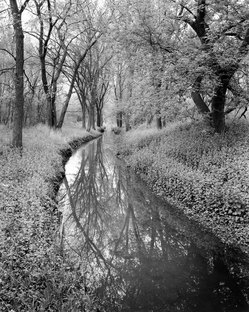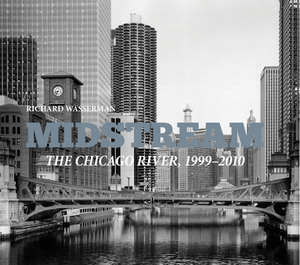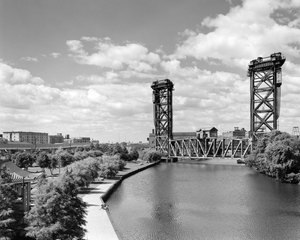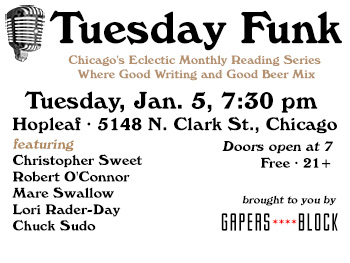| « Get Your Nerd On at C2E2 This Weekend! | Bookmarks » |
Reviews Fri Apr 13 2012
Photographing the Chicago River
 When you think of the Chicago River, what springs to mind? Most likely, the bridge at Michigan Avenue, kayaking in the summer, architectural boat tours, and assuredly the famous reversal over a century ago. There's a lot of river that extends beyond the downtown area, however — all 156 miles of it — most of which you may not recognize.
When you think of the Chicago River, what springs to mind? Most likely, the bridge at Michigan Avenue, kayaking in the summer, architectural boat tours, and assuredly the famous reversal over a century ago. There's a lot of river that extends beyond the downtown area, however — all 156 miles of it — most of which you may not recognize.
Photographer Richard Wasserman spent 10 years learning every fork and tributary of the Chicago River, documenting it on his large format camera. This type of black and white photography, chosen both for the incredible detail it offers and for its ability to capture architecture without distortion, took a lot of care — not to mention, time — to execute.
"It looks very simple, and it is," said Wasserman, referring the large format process. "But an amazing amount of things can go wrong." It took Wasserman anywhere from 30-60 minutes to set up the equipment and capture a final image.
On average once weekly, and often on weekends, he added to his collection of river photographs — including the piles of boxes of unused prints and negatives never printed — not thinking it would be anything more than a personal project. It wasn't until he attended a workshop in Pennsylvania four or five years ago that someone gave him the idea for a book.
 Midstream, recently published by the Columbia College Chicago Press, is a collection of 104 of these images of the river, including some of the Skokie Lagoons and where the river passes, unassuming, by the Northbrook Court Shopping Mall.
Midstream, recently published by the Columbia College Chicago Press, is a collection of 104 of these images of the river, including some of the Skokie Lagoons and where the river passes, unassuming, by the Northbrook Court Shopping Mall.
Beyond being lovely to behold, the images are important historical records of part of Chicago's built environment: the river, and how humans have interacted, fiddled, and messed with it for two centuries. Although there are no people in these images, they were never far from Wasserman's mind. "I think about people just as much, even if they're not pictured," he said, discussing how the relationship between the river and Chicago's residents has changed over the years.
Currently, Wasserman is working on two projects, for which he continues to focus on recording what has changed, and what might be forgotten. In addition to documenting old movie theaters in Chicago and the surrounding suburbs, the other project, "Eminent Domain," has taken him across the country to places confiscated by the government for the "public good" — such as Bensenville, Illinois, where 600 families and 25 businesses were displaced thanks to the expansion of the O'Hare airport; or Norris, Tennessee, where the first TVA dam displaced upwards of 3,000 families.
"People forget. Society forgets," he said. "Some [of these] changes are good, but the people who pay the highest price are those who have no voice."
Wasserman will be signing copies of his book on May 1, from 6pm to 8pm at the Lincoln Park Campus of DePaul University (2400 N. Sheffield Ave.). On May 31, he will be speaking and showing select photographs from Midstream at the McCormick Bridgehouse Musuem (376 N. Michigan Ave.) during lunch.











